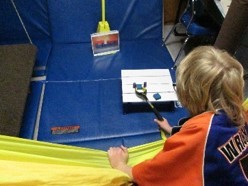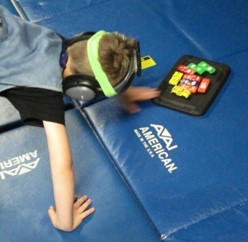The fabric of the hammock was silky and didn’t cling to the skin like the Lycra swing. So we didn’t use it primarily to enhance body awareness in the same way we used the Lycra swing. Instead, we found ourselves using it for pushing and pulling, climbing and rolling movement patterns. These coordinated types of movement patterns are the same ones required for daily living skills such as dressing, brushing teeth, and using utensils that our children find difficult.
For example, children need to use both hands for pushing and pulling while pushing arms forward to steer a bicycle, pulling up pants, pulling down ski hats onto their heads, pulling on shoes, soaping a wash cloth etc. Meanwhile climbing movement patterns where the arms are pulling while the legs are pushing are used to climb up steps, climb into a car seat, and while climbing onto playground equipment. These movement patterns all tend to activate the “core” muscles of the trunk to perform steadying, stabilizing moves while the extremities are involved in performing skilled tasks. For example, standing on one leg while lifting the other leg to put on pants, requires stabilization of the core muscles on one side of the trunk, while the other side of the body is involved in performing skilled moves of the feet.
While these movement patterns incorporate using both arms and legs performing the same types of action at the same time, daily living skills also require the ability to use arms and legs in reciprocal, alternating, or bilateral patterns of movement.
These gross motor movement patterns need to be refined in preparation for performing fine motor skills such as when one hand uses a fork to spear a meatball and holds the fork steadily so that the other hand can manipulate a knife for cutting. Another example would be found when one hand holds a button hole open, while the other hand manipulates the button to slide through the hole. In both instances, one hand acts to hold something still, while the other hand manipulates a tool such as a pencil.
When children have coordination deficits, these basic patterns of movement tend to be disorganized and rehearsal is needed. Intentionally setting up equipment to rehearse the deficient motor patterns within the context of “play”, helps to reduce anxiety while motor learning occurs. The imagination is stimulated, and appropriate motor patterns tend to emerge given gentle prompts. As a result, we find that the child engages, rather than avoids the learning task, and exercise is able to take place without frustration.
 Motor planning takes place as the child looks over the equipment and makes a plan of action to engage the task. Motor planning requires an appreciation of body scheme and awareness of where the body parts are in space in relation to the object(s). In addition, an internalized sequence of the series of moves that will be engaged needs to be planned and then played out.
Motor planning takes place as the child looks over the equipment and makes a plan of action to engage the task. Motor planning requires an appreciation of body scheme and awareness of where the body parts are in space in relation to the object(s). In addition, an internalized sequence of the series of moves that will be engaged needs to be planned and then played out.
 This child will be using a reacher to grasp and position blocks to match the arrangement shown on the task card. He will have to steady his grasp on the reacher and not drop the block while he positions his body. Then he will have to place the block on the table to construct the assembly. This is a multi-step activity that requires focused attention to task.
This child will be using a reacher to grasp and position blocks to match the arrangement shown on the task card. He will have to steady his grasp on the reacher and not drop the block while he positions his body. Then he will have to place the block on the table to construct the assembly. This is a multi-step activity that requires focused attention to task.
 Bilateral motor integration and/or reciprocal stabilization occurs as the child spontaneously stabilizes half of the upper body so that the other half can acquire and mobilize the target. This child will be picking up a car to match the color of a ring on the floor grid. The cars have been intentionally placed on opposite sides (right/left) of the hammock and also at opposite ends (north/south) so that he will have to re-orient himself in space to complete the task.
Bilateral motor integration and/or reciprocal stabilization occurs as the child spontaneously stabilizes half of the upper body so that the other half can acquire and mobilize the target. This child will be picking up a car to match the color of a ring on the floor grid. The cars have been intentionally placed on opposite sides (right/left) of the hammock and also at opposite ends (north/south) so that he will have to re-orient himself in space to complete the task.
 The use of manipulatives to match color, size, or shape at lower levels of cognitive ability has been intentionally selected in order to allow executive functions to monitor and plan motor moves.
The use of manipulatives to match color, size, or shape at lower levels of cognitive ability has been intentionally selected in order to allow executive functions to monitor and plan motor moves.

Comments are closed.